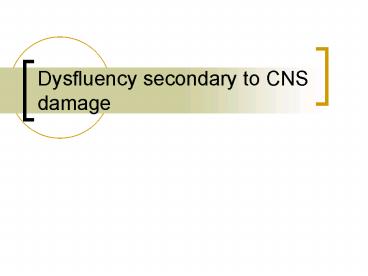Dysfluency secondary to CNS damage - PowerPoint PPT Presentation
1 / 14
Title:
Dysfluency secondary to CNS damage
Description:
True neurogenic stuttering is also known as 'acquired' ... Disfluency stemming from anomia. Palilalia. Dysarthric disfluency ... Dysfluency stemming from anomia ... – PowerPoint PPT presentation
Number of Views:240
Avg rating:3.0/5.0
Title: Dysfluency secondary to CNS damage
1
Dysfluency secondary to CNS damage
2
Subgroups of acquired fluency disorders
- True neurogenic stuttering is also known as
acquired or cortical stuttering. - However, it must be distinguished from other
fluency disturbances following CNS damage that
share few features with classic stuttering - Subgroups include
- Dysarthric disfluency
- Apraxic disfluency
- Disfluency stemming from anomia
- Palilalia
3
Dysarthric disfluency
- This category includes Parkinsonian patients, who
often demonstrate - Frequent prolongations
- Rapid sound, syllable and word repetitions
- blocking associated with failure to progress to
the next articulatory target - Symptoms worsen as the disease progresses (Benke,
et al., 2000) levodopa treatment may further
aggravate fluency (Louis, et al., 2001)
4
Dysarthria (continued)
- PD may prompt re-emergence of developmental
stuttering (Shahed Jonkovic, 2001). - Ataxic dysarthrics may show
- Long prolongations
- Easy repetitions
5
Other subgroups
- Apraxic dysfluency apraxic patients often repeat
initial segments while groping for the
appropriate target this needs to be
distinguished from the stuttering behavior of
perseverative repetitions of the correct target,
as in true stuttering. Both may be seen in
apraxia. - Some people have suggested that the two disorders
share a common neurological basis.
6
Dysfluency stemming from anomia
- Dysfluencies are characterized primarily by
pausing, articulatory groping, and the
interjection of filled pauses and/or phrase
repetitions while searching for lexical targets. - Usually, other additional aphasic symptoms are
present - Wernickes patients may be more prone to this
pattern of dysfluency than other aphasic
syndromes.
7
Palilalia
- Found in a number of neurological conditions
(including Parkinsons), speech is characterized
primarily by - word and phrase repetitions (NOT) sound or
syllable repetitions) that may become
increasingly more rapid, and progressively more
unintelligible.
8
True cortical stuttering
- Quite rare
- Typically documented in the literature through
isolated case studies - Patients show true stutter-like symptoms which
cannot be attributed to neuromotor or language
planning disturbance
9
Causes of cortical stuttering
- Stroke, typically multiple and bilateral events
- However, site of lesion has been reported to be
extremely variable (Franco, et al., 2000
including subcortical regions Ciabarra, et al.,
2000) and occasionally subtle enough to be
detected only using very sophisticated measures
(e.g., SPECT, Heuer, et al., 1996). - This variability has impeded the use of acquired
stuttering cases to shed light on the underlying
defect in developmental stuttering. - Stroke sometimes prompts return of resolved
developmental stuttering (Mouradian, et al., 2000)
10
Causes (continued)
- Penetrating objects and tumors
- Occasionally, there are reports of stuttering
caused/cured by removal of tumors or invasive
objects - CHI these cases typically show
- bilateral involvement
- loss of consciousness after injury
- Development of seizure disorder
- Emergence of stuttering following establishment
of seizure disorder - Senile and dialysis dementia
11
Drug-induced stuttering
- A wide number of medications have been reported
to induce disfluency, including some that have
been shown to marginally increase fluency in
developmental stuttering (Brady, 1998). - Similarly, while trials continue to explore the
use of medication in alleviating stuttering
(e.g., resperidone, Maguire, et al., 2000)),
there is some consensus that medications will
best augment, rather than replace, conventional
therapy in stuttering treatment.
12
Overlap Neurogenic and psychogenic stuttering
- Psychogenic stuttering, while rare, typically
shows some symptom overlap with neurogenic
dysfluency - Patients often show evidence of some degree of
neurological insult or disease state - Differential diagnosis is important, and focuses
on ruling out potential alternative explanations
for the dysfluency, while gauging pt. profile
similarity to known neurogenic subgroups (see
Helm-Estabrooks Hotz (1998) for case study
example.)
13
Features of neurogenic and psychogenic
stuttering (from Manning, 2001)
- NEUROGENIC
- Disfluencies on function as well as content words
- Speaker annoyed but not usually anxious
- Behaviors not solely on initial syllables
- Secondary symptoms not linked to disfluencies
- Lack of adaptation effect
- lack of variability across speaking tasks and
situations
- PSYCHOGENIC
- Rapid and favorable response to limited treatment
- Bizarre struggle and other signs of anxiety
- Stuttering may be episodic
- Stuttering pattern differs from both
developmental and neurogenic stuttering
14
Treatment
- If stuttering is accompanied by seizure disorder,
medications to control seizures often ameliorate
dysfluency - Remission most often occurs within three months
persistent cases have less favorable prognosis - Combination of fluency shaping (emphasis on rate
and pacing) and stuttering modification (to
reduce struggle) is most often recommended.
Limited efficacy data are available.































